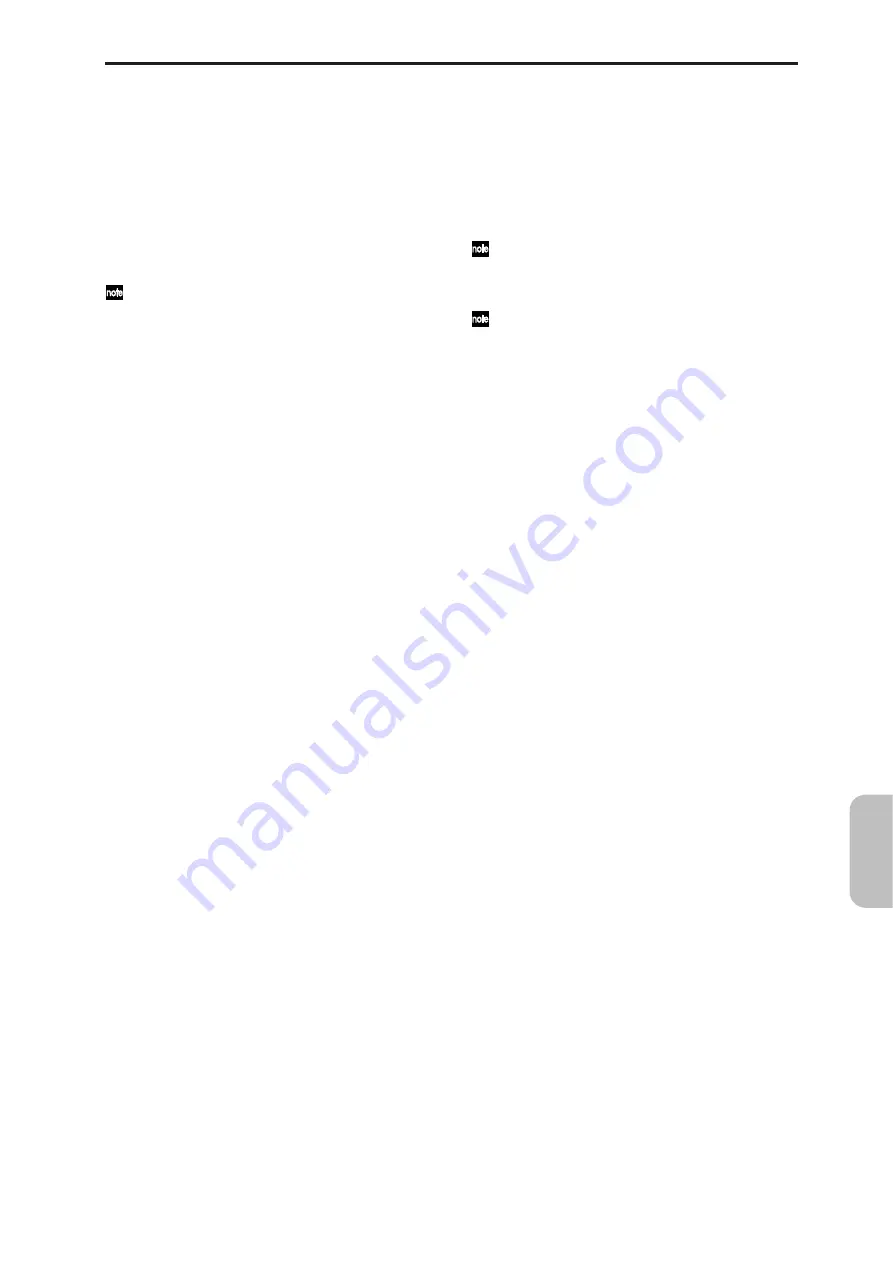
173
Ap
pendic
es
joystick is operated. Normally, a wah effect (filter LFO) is
applied.
microX:
When you move the microX’s joystick in the –Y
direction (down), Modulation 2 Depth messages will be
transmitted. When these messages are received, the same
effect will be applied as when the X50/microX’s joystick is
operated. Normally this will apply a wah effect (filter LFO).
• In Combination and Multi modes, transmission/
reception can be switched on/off for each timbre/track.
(
☞
“JS–Y CC#02” COMBI 3–2a, MULTI 3–5(6)a)
Other manufacturers use this message for other pur-
poses (e.g., breath controller, etc.)
Controlling the portamento effect
Portamento time (CC#05) [Bn, 05, vv]
When the above CC# is assigned as a B-mode function for
one of the REALTIME CONTROLS [1]–[4] knobs, rotating
that knob will transmit Portamento Time messages, and will
modify the speed at which the portamento pitch changes.
When this message is received, the result will be the same as
when the controller is operated.
Portamento switch (CC#65) [Bn, 41, vv]
When the above CC# is assigned to ASSIGNABLE SWITCH
etc., operating that switch will transmit vv=127 [7F] for ON
or vv=0 [00] for OFF, and the portamento effect will be
switched on/off. When this message is received, the result
will be the same as when the controller is operated. (vv of 63
[3F] or less will be OFF, and 64 [40] or greater will be ON.)
(
• In Combination and Multi modes, transmission/
reception of this message can be turned on/off
independently for each timbre/track. (“Portamento SW
CC#65” COMBI 3–2a, MULTI 3–3(4)a)
• In Multi mode, portamento time/switch messages will
be transmitted by each track whose “Status” is BTH,
EXT
, or EX2 when you set “Portamento” (MULTI 3–
3(4)a), re-select a multi set (when “MULTI mode”
(GLOBAL 0–2a) is for Master). (
Controlling the volume
Volume (CC#07) [Bn, 07, vv]
When the above CC# is assigned to the ASSIGNABLE
PEDAL or as the B-mode function of a REALTIME CON-
TROL knob [1]–[4], operating that controller will transmit
Volume messages, and the volume will change. When this
message is received, the result will be the same as when the
controller is operated.
Expression (CC#11) [Bn, 0B, vv]
When the above CC# is assigned to the ASSIGNABLE
PEDAL or as the B-mode function of a REALTIME CON-
TROL knob [1]–[4], operating that controller will transmit
Expression messages, and the volume will change. When
this message is received, the result will be the same as when
the controller is operated.
The volume of the X50/microX is determined by summing
the value of the Volume message with the value of the
Expression message
.
If adjusting the Volume message does not increase the vol-
ume as you expect, or if there is no sound, transmit MIDI
messages from an external device to reset the value of the
Expression message (set vv to 127).
• In Combination mode, Volume messages will be
transmitted by each timbre whose “Status” is EXT or
EX2
when you re-select the combination.
• When you change the “Volume” setting (MULTI 0–4(5))
in Multi mode, or when you re-select the multi set (when
“Multi mode” (GLOBAL 0–2a) is for Master) in Multi
mode, volume messages will be transmitted by each
track whose “Status” is BTH, EXT, or EX2.
Regardless of the “Status” settings, re-selecting a multi
set, or returning to the beginning will reset the internal
Volume value to the value specified by each track, and
will reset the Expression value to the maximum.
You can control the volume independently for each
track. You will normally use Volume messages to set the
initial volume level for each track, and use Expression
messages to create changes in dynamics within the
musical data of the song.
By using the universal exclusive Master Volume message,
you can adjust the overall volume without changing the vol-
ume balance between timbres or tracks. (
Controlling panning (stereo position)
Pan (CC#10) [Bn, 0A, vv]
(vv: value, where 00 is far left, 64 is center, and 127 is far
right)
When the above CC# is assigned to the ASSIGNABLE
PEDAL or as the B-mode function of a REALTIME CON-
TROLS knob [1]–[4], operating that controller will transmit
Pan messages, and the panning will change. When this mes-
sage is received, the result will be the same as when the con-
troller is operated.
• When you set the “Pan” (MULTI 0–4(5)) in Multi mode,
or when you re-select the multi set (when “Multi mode”
(GLOBAL 0–2a) is for Master) in Multi mode, Pan
messages (except for RND) will be transmitted by each
track whose “Status” is BTH, EXT, or EX2 (
Post insert effect pan (CC#08) [Bn, 08, vv]
(vv: value, where 00 is far left, 64 is center, and 127 is far right)
When the above CC# is assigned to the ASSIGNABLE
PEDAL or as the B-mode function of a REALTIME CON-
TROLS knob [1]–[4], operating that controller will transmit
Post Insert Effect Pan messages, and the panning of the
sound following the insert effect will change. When this
message is received, the result will be the same as when the
controller is operated.
• In Program mode, this message is transmitted and
received on the global MIDI channel. In Combination
and Multi modes, this is transmitted and received on the
MIDI channel specified for each insert effect.
• When you set “Pan (CC#8)” (MULTI 8–3a) in Multi
mode, or when you re-select the multi set (when “Multi
mode” (GLOBAL 0–2a) is for Master) in Multi mode,
Post Insert Effect Pan message will be transmitted by
each track whose “Status” is BTH, EXT, or EX2 (
Effect control
Effect control 1 (CC#12) [Bn, 0C, vv]
Effect control 2 (CC#13) [Bn, 0D, vv]
When the above CC# is assigned to the ASSIGNABLE
PEDAL or as the B-mode function of a REALTIME CON-













































